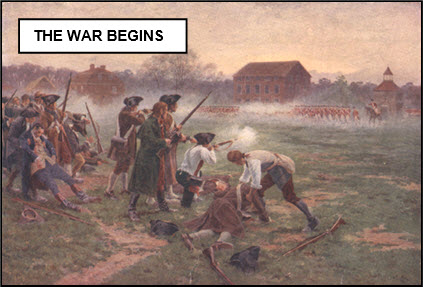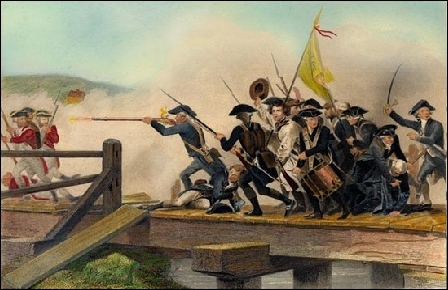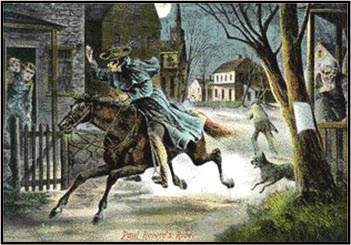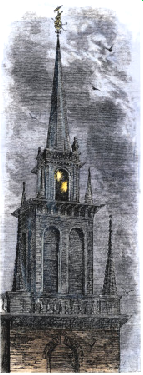


THE AMERICAN WAR OF INDEPENDENCE
1775 -
THE OPENING BATTLES OF LEXINGTON and CONCORD 1775
xxxxxThe Battle of Lexington in 1775 was nothing more than a skirmish, but it proved the start of the American War of Independence (the American Revolution). Pre-
 xxxxxThe Battle of Lexington was more of a skirmish than a serious military engagement, but it nonetheless marked the beginning of the American War of Independence (the American Revolution). Having been ordered to seize the military stores held by the colonists at Concord, Massachusetts, a British force of some 700 men was dispatched from Boston and, in the early hours of April 19th 1775, was suddenly confronted on Lexington Green by some 70 minutemen (men ready to fight "in a minute"). They were ordered to disperse, but their commander, a Captain John Parker, told his men to stand their ground. If the British wanted a war, he is alleged to have said, then “let it begin here”. Then a shot rang out, and it did just that. It is not known who fired the shot, but in the brief encounter that followed, the Americans were forced to retreat after losing eight men.
xxxxxThe Battle of Lexington was more of a skirmish than a serious military engagement, but it nonetheless marked the beginning of the American War of Independence (the American Revolution). Having been ordered to seize the military stores held by the colonists at Concord, Massachusetts, a British force of some 700 men was dispatched from Boston and, in the early hours of April 19th 1775, was suddenly confronted on Lexington Green by some 70 minutemen (men ready to fight "in a minute"). They were ordered to disperse, but their commander, a Captain John Parker, told his men to stand their ground. If the British wanted a war, he is alleged to have said, then “let it begin here”. Then a shot rang out, and it did just that. It is not known who fired the shot, but in the brief encounter that followed, the Americans were forced to retreat after losing eight men.
Acknowledgements
Lexington: by the English painter William Barnes Wollen (1857-
G3a-
Including:
Paul Revere

xxxxxThe Battle of Concord followed on from the opening skirmish at Lexington. Having reached the town, the British force of some 700 men were soon engaged in a battle for Old North Bridge. Here about 200 militiamen held on to their position on the far side of the bridge, despite a number of attacks by the redcoats. Eventually the British regulars withdrew and, having found little of the military equipment they were sent to confiscate, started their march back to Boston. It proved a costly return journey. Using hit-
 xxxxxAfter the skirmish at Lexington, the redcoats then continued their march to Concord, arriving there about 7.30 am. Here, however, they found that most of the military supplies had been destroyed or hidden. There then followed the Battle of Concord, a brief but significant engagement at the town's Old North Bridge. About 200 militiamen took up a position across the River Concord on the far side of the bridge. Despite several attempts, the British were unable to dislodge them, and were eventually forced to fall back and begin their return journey. For them, this proved a disaster. Using hit-
xxxxxAfter the skirmish at Lexington, the redcoats then continued their march to Concord, arriving there about 7.30 am. Here, however, they found that most of the military supplies had been destroyed or hidden. There then followed the Battle of Concord, a brief but significant engagement at the town's Old North Bridge. About 200 militiamen took up a position across the River Concord on the far side of the bridge. Despite several attempts, the British were unable to dislodge them, and were eventually forced to fall back and begin their return journey. For them, this proved a disaster. Using hit-
xxxxxIncidentally, in 1874 a stone replica of Old North Bridge, and a statute entitled The Minute Man were erected to mark the site of the Battle of Concord. The American sculptor concerned, Daniel Chester French (1850-
 xxxxxThatxthe colonists were given warning of the British advance on Concord was due to the historic midnight ride by the patriot Paul Revere (1735-
xxxxxThatxthe colonists were given warning of the British advance on Concord was due to the historic midnight ride by the patriot Paul Revere (1735-
 xxxxxTwo days before making his dramatic ride through the night, Revere had set up a warning system in Boston to warn the city and surrounding areas of a pending attack. One lantern alight in the steeple of Boston's Old North Church (illustrated) meant that the British were approaching by land, two gave warning that they were arriving by sea!
xxxxxTwo days before making his dramatic ride through the night, Revere had set up a warning system in Boston to warn the city and surrounding areas of a pending attack. One lantern alight in the steeple of Boston's Old North Church (illustrated) meant that the British were approaching by land, two gave warning that they were arriving by sea!
xxxxxThe man destined to be an American folk hero was born in Boston and, as a young man, acquired widespread fame as an outstanding designer and maker of high quality silverware. He also turned his hand to engraving and, as an ardent patriot, was responsible for the famous engraving of the Boston Massacre of 1770, a version of the incident which was more a propaganda piece than a work of historical accuracy. In 1773 he took part in the Boston Tea Party, and it was after this that he became a courier for the revolution. During the conflict he used his skill to print money for the Massachusetts Congress, designed the colony's official seal -
xxxxxThat the colonists were given warning of the British advance on Concord was due to the famous midnight ride by the patriot Paul Revere (1735-


